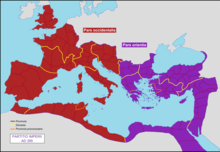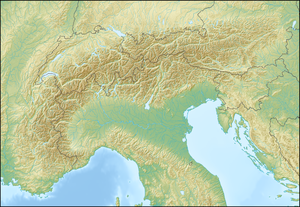Battle of the Frigidus
| Battle of the Frigidus | |||||||||
|---|---|---|---|---|---|---|---|---|---|
 Battle of the Frigidus by Johann Weikhard von Valvasor (1689) | |||||||||
| |||||||||
| Belligerents | |||||||||
|
Eastern Roman Empire Visigoths | Western Roman Empire | ||||||||
| Commanders and leaders | |||||||||
|
Theodosius I Timasius Stilicho Alaric Bacurius † Gainas |
Eugenius Arbogast † | ||||||||
| Units involved | |||||||||
| Herculiani seniores | |||||||||
| Strength | |||||||||
|
20,000–30,000 Romans 20,000 Goths[1] | 35,000–50,000, about the same as Eastern Romans | ||||||||
| Casualties and losses | |||||||||
|
Heavy[2] 10,000 Goths[3] | Heavy[2] | ||||||||
Location of the battle within Slovenia | |||||||||

The Battle of the Frigidus, also called the Battle of the Frigid River, was fought on 5 and 6 September 394 between the armies of the
In
Background

On 15 May 392, the western emperor,
On 22 August, Arbogast elevated
Campaign preparation
Over the following year and a half Theodosius marshalled his forces for the invasion. The Eastern armies had atrophied since the death of the Emperor Valens and most of his soldiers at the Battle of Adrianople. It fell upon the generals Flavius Stilicho and Timasius both to restore discipline to the legions and to bring them back up to strength through recruitment and conscription.
At the same time another of Theodosius's advisers, the eunuch
, the old monk prophesied that Theodosius would achieve a costly but decisive victory over Eugenius and Arbogast.

The Eastern army set out towards the west from Constantinople in May 394. The re-galvanized legions were bolstered by numerous barbarian auxiliaries including over 20,000
Their advance through Pannonia until the Julian Alps was unopposed, and Theodosius and his officers must have had suspicions about what lay ahead when they discovered that the eastern ends of the mountain passes were undefended. Arbogast had, based on his experiences fighting against the usurper
Thanks to Arbogast's strategy of maintaining a single, relatively cohesive force, the Theodosian army passed unhindered through the Alps and descended towards the valley of the Frigidus River to the east of the Roman port of Aquileia. It was in this narrow, mountainous region that they came upon the Western army's encampment within the Claustra Alpium Iuliarum in the first days of September.
The battle
It is uncertain exactly where the battle took place. Though it has been claimed that the location of the battle should be sought in the Upper Isonzo Valley, it has mostly been placed somewhere in the Vipava Valley. Whereas the "Frigidus" has been usually considered to be the Vipava River or Hubelj Creek and the battle to take place near Vrhpolje, recent research suggests that it actually took place some kilometers away, between Col and Sanabor in the so called Door to Roman Italia.[4]
Before the battle, Eugenius and Arbogast placed a statue of Jupiter on the edge of the battlefield, and had applied images of Hercules on the army banners.[5] This way they hoped to repeat the victories of Rome in earlier days, when it had always relied on the old gods for support in battle. On the first day of battle the old gods seemed to be winning. Theodosius attacked almost immediately, having undertaken little to no prior reconnaissance of the field of battle. He committed his Gothic allies to action first, perhaps hoping to thin their ranks through attrition and lessen their potential threat to the Empire. The Eastern army's headlong attack resulted in heavy casualties but little gain: 10,000 of the Gothic auxiliaries are reported to have been slain, and the Georgian general Bacurius was among the dead.[6]
Day's end saw Eugenius celebrating his troops' successful defense of their position while Arbogast sent out detachments to close off the mountain passes behind Theodosius's forces.
After a sleepless night, Theodosius was cheered by the news that the men Arbogast had sent to bottle him up in the valley intended to desert to his side. Buoyed by this favorable development, Theodosius' men attacked once again. This time nature was on their side as a fierce tempest—apparently the bora, a regular occurrence in the region—blew along the valley from the east. Other stories tell of Theodosius praying to God for a storm, which God subsequently granted.[7]
The high winds blew clouds of dust into the faces of the Western troops (legend also says that the fierce winds even blew the Western troops' own arrows back at them). Buffeted by the winds, Arbogast's lines broke and Theodosius gained the decisive victory that the Egyptian monk had prophesied.
In the aftermath, Eugenius was captured and brought before the emperor. His pleas for mercy went unanswered and he was beheaded. Arbogast escaped the defeat and fled into the mountains, but after a few days' wandering, he concluded escape was impossible and committed suicide.
Religious character of the conflict
While the version of the battle in which a divine wind defeated the pagan enemies of Theodosius became popular in late antiquity, modern historians, most notably
In addition, the earliest source to mention the decisive bora wind was
Historian Michele Renee Salzman explains that "two newly relevant texts — John Chrysoston's Homily 6, adversus Catharos (PG 63: 491-92) and the Consultationes Zacchei et Apollonii, re-dated to the 390s, reinforce the view that religion was not the key ideological element in the events at the time".[10] According to Maijastina Kahlos, Finnish historian and Docent of Latin language and Roman literature at the University of Helsinki, the notion of pagan aristocrats united in a "heroic and cultured resistance" who rose up against the ruthless advance of Christianity in a final battle near Frigidus in 394, is a romantic myth.[11]
Aftermath
It had been a costly victory for Theodosius and a total loss for Eugenius. A contemporary Roman historian stated that since the Goths suffered the bulk of the casualties, Theodosius won two battles at Frigidus, one against Eugenius and the other against the Goths.[12] A mere four months later he died, leaving the government in the hands of his young children Honorius and Arcadius.
However, the battle also accelerated the collapse of the Roman army in the west. The losses at the Battle of the Frigidus weakened the western legions. This downturn in the capabilities of the Roman soldiers meant an increasing reliance by the Empire on barbarian mercenaries employed as foederati, who often proved to be unreliable, or even treacherous.
References
- ^ John Julius Norwich, Byzantium: The Early Centuries, 115
- ^ a b Williams & Friell 1994, p. 66.
- ^ Baynes 1911, p. 247.
- ISSN 1408-5348.
- ISBN 978-0-8006-9747-1. Retrieved 3 April 2013.
- ^ Williams & Friell 1994, p. 118.
- ISBN 978-90-04-10571-3. Retrieved 3 April 2013.
- Alan Cameron, The Last Pagans of Rome (New York: Oxford University Press, 2011), 93–107
- Alan Cameron, The Last Pagans of Rome (New York: Oxford University Press, 2011), 112–17
- S2CID 143665912.
- ^ Kahlos, p. 2.
- ^ Heather 2010, p. 194.
Sources
Primary sources
- Rufinius. Historia Ecclesiastica. Vol. 11.
Secondary sources
- Baynes, Norman H. (1911). H.M.Gwatkin and J.P. Whitney (ed.). The Dynasty of Valentinian and Theodosius the Great. Vol. 1. Cambridge University Press.
- Heather, Peter (2010). Empires and Barbarians: The Fall of Rome and the Birth of Europe. Oxford University Press.
- Kahlos, Maijastina (2019). Religious Dissent in Late Antiquity, 350–450. Oxford University Press. ISBN 978-0-19-006725-0.
- Kohn, George Childs. Dictionary of Wars (Revised ed.).
- Williams, Stephen; Friell, Gerard (1994). Theodosius: The Empire at Bay. Yale University Press. ISBN 978-0-300-07447-5.
- White, Cynthia (2010). The Emergence of Christianity: Classical Traditions in Contemporary Perspective. Fortress Press. ISBN 978-0-8006-9747-1.


